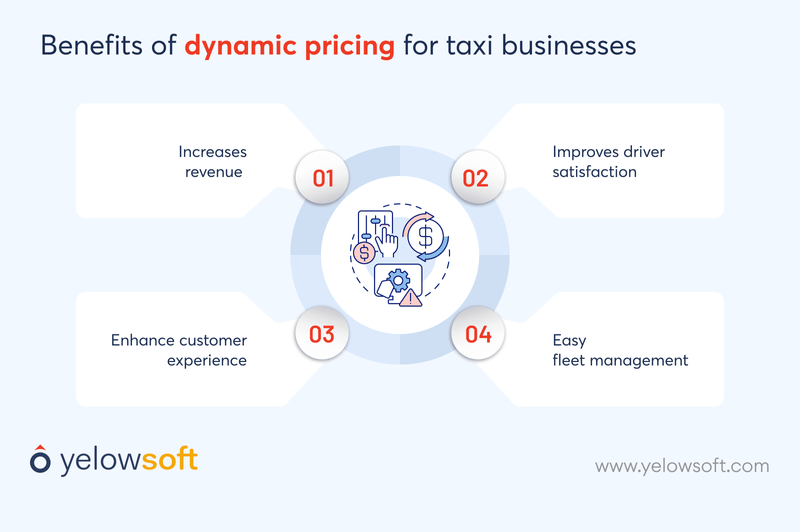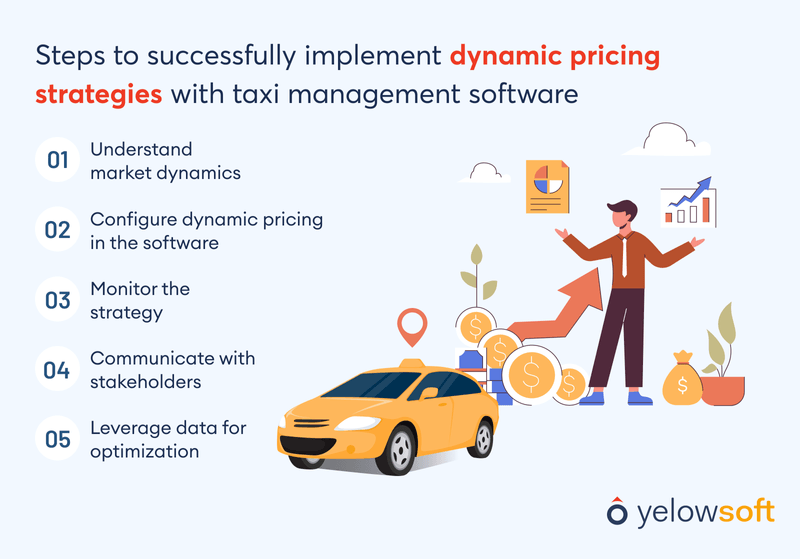Implementing a dynamic pricing strategy with the taxi management software in your taxi business is not rocket science. It is a systematic process that any taxi business owner like you can implement.
But, the only requirement is - you should have reliable taxi management software with dynamic pricing features.
Moreover, if you are:
- Struggling to balance supply and demand while maintaining profitability
- Frustrated watching competitors scale and thrive while your business remains stagnant
- Unable to keep your fleets busy, drivers happy, and customers satisfied
- Facing other problems that generate a fear of losing profit and reputation
Then this blog is for you.
Here, you will explore every single step that you need to implement dynamic pricing strategies successfully with taxi management software.
Furthermore, you will also discover the benefits of dynamic pricing for taxis.
Let’s start with an overview of dynamic pricing in the taxi industry.
Overview of dynamic pricing in the taxi industry
It is a pricing strategy that helps taxi business owners like you to adjust fares in real time, based on demand and supply.
In simple words, it allows you to adjust taxi fares based on peak hours in:
- Festive season
- Events (football matches, etc) and more…
The aim of this taxi management software feature is to balance the number of passengers and taxis on the road while reducing wait times for passengers and increasing revenue for your taxi business at the same time.
Let’s understand with an example.
Consider it’s rush hour in New York City. The streets are packed with commuters which has raised the demand for taxis.
This will also be considered as peak hours. If you follow the traditional flat-rate pricing in these peak hours, you will not be able to fulfil rides and ultimately will miss earning revenue opportunities.
However, if you apply the dynamic pricing strategy, you will be able to adjust fares in real time. Plus, you will also remain profitable even when demand is high.
But the thing is, to apply a dynamic pricing strategy in your taxi business, you would need a taxi management software. And below, you will explore it in detail.
This is what dynamic pricing is. Let’s now understand the significance of using dynamic pricing taxi management software.
Importance of using dynamic pricing taxi management software
The experience and expertise are not enough to grow your business. You will need beyond it. And that is advanced taxi management software with a built-in dynamic pricing feature.
Explore its importance:
- It helps in maximizing revenue and customer satisfaction
- Allows you to minimize losses and capitalize on peak hours
- It enables you to streamline operations, reduce wait times, and improve driver efficiency
- You get valuable insights into passenger behaviors and preferences
- Empowers you to make data-driven decisions
- Helps you to keep your drivers motivated
Now that you know the overview and importance of dynamic pricing in the taxi industry, it’s time to understand the benefits of dynamic pricing for taxis.
Benefits of dynamic pricing for taxi businesses
The benefits of implementing dynamic pricing in taxis are clear and manifold.

Firstly, it maximizes your revenue
By adjusting fares based on the market demand and peak hours, you can charge the optimal price for every ride when demand is high. This will help you increase your revenue potential.

Secondly, it improves your driver satisfaction
It allows you to compensate your drivers fairly during busy times or peak hours. When your drivers earn more, then the money becomes their motivation and hence it improves your driver satisfaction.
Thirdly, it enhances your customers' experience
Regardless of the price and peak hours, customers prefer getting the ride on time whenever they need it. This way you ensure better and convenient service to your customers. And hence, it enhances your customer experience.
Also read: How to boost your customer experience with taxi dispatch software
Lastly, enables you to manage your fleets efficiently
Dynamic pricing features in the taxi booking management software can help you distribute your fleets more evenly across your predefined zone. This way you operate and manage your fleets and drivers more efficiently.
Read more: The role of mobile apps in modern taxi management
You are now well aware of the importance and benefits of dynamic pricing strategies for taxi services.
Here is the cream of the blog - steps to implement dynamic pricing in your taxi business using taxi business management software.
5 Steps to successfully implement dynamic pricing strategies with taxi management software
In today’s digital era and fast-paced world, staying competitive means being adaptable. One of the most effective ways to achieve this is by implementing a dynamic pricing strategy.
But the question is how to implement this.

Follow the below-mentioned 5 steps and you will successfully implement it.
Step 1: Understand the market dynamics
Before you jump into the technical aspects of setting dynamic pricing, you need to have a clear understanding of your market.
The first thing you need to do is;
Analyze demand patterns and peak times
Analyze the demand patterns for your taxi services by asking these questions to yourself.
- When do most of my customers request rides?
- Are there specific times or days when demand sparks?
Answer these questions and understand the patterns. This will allow you to create a pricing strategy that will align with your customer needs.
Assess competition and customer expectation
Next, take a close look at your competitors. Identify their strengths and weaknesses by knowing;
- What pricing strategies are they using?
- Are they also employing dynamic pricing, or are they sticking to fixed rates?
Once you know what your competitors are doing, you will be able to position your pricing strategy more effectively.
Moreover, it is also important to consider your customer expectations.
Modern customers are tech-savvy and understand the concept of dynamic pricing. They expect fair pricing.
Hence, ensure your dynamic pricing model is easy to understand. This will help you build trust and loyalty among your customers.
Step 2: Configuring dynamic pricing in taxi management software
Once you have a solid grasp of your market dynamics, the next step is to configure your taxi management software to implement dynamic pricing.
This involves setting up pricing rules and customizing algorithms to respond to various scenarios.
Setup pricing rules based on demand, time, and location
Your taxi management software should allow you to set up pricing rules that adjust fares based on specific criteria such as;
- Demand
- Time of day
- And location
For example, you can set a rule in the software that automatically increases price during peak hours, high demands, festive seasons, football matches or any political event.
The same you can set lower price rules during off-peak hours to encourage more bookings.
Customize pricing algorithms for different scenarios
With the right taxi management software, you will get a customization option for pricing algorithms. It means you can tailor the dynamic pricing model to suit different scenarios unique to your business.
Different scenarios may include;
- Weekdays
- Weekends
- Trip to suburban areas
- Trip to urban areas
This way, you can ensure your dynamic pricing strategy remains flexible and responsive to the ever-changing market conditions.
Step 3: Monitor and adjust the strategy
Dynamic pricing is not a set-it-and-forget-it solution. It requires continuous monitoring and adjustment to ensure it’s working as intended. Here is how you can do it.
Continuously monitor performance with real-time data Your taxi management software should provide real-time data on how your pricing strategy is performing. This includes metrics such as;
- The number of rides
- Average fare per ride
- Driver availability, and
- Customer satisfaction
Regularly review these metrics to identify trends and make informed decisions about when and how to adjust your pricing rules.
Make adjustments based on driver feedback and customer response
Driver and customer feedback are invaluable when fine-tuning your dynamic pricing strategy.
Drivers are on the front lines and can provide you the insights on how pricing changes affect their work and income.
For instance, the driver can tell you about the high pricing that can lead to fewer rides. And also can inform you about the low pricing which will lead to inadequate earnings. Their feedback can help you adjust the strategy.
Similarly, with the taxi booking management software, you can keep an eye on customer responses. You will know that;
- Are your customers complaining about price hikes during certain times?
- Are they dropping off during peak pricing periods?
Use this feedback to strike a balance between profitability and customer satisfaction.
Step 4: Communicate with stakeholders
Effective communication is key to the successful implementation of dynamic pricing.
Both your drivers and customers need to understand how dynamic pricing works and how it benefits them. Do the following for better communication.
Ensure transparency with your drivers about fare adjustments
Drivers are the critical stakeholders in your taxi business. They need to understand how and why fare adjustments happen so they can make the most of peak times and optimize their earnings.
You should regularly update your drivers on any changes to the dynamic pricing model and provide them with tools (driver app) to track their performance and earnings in real time.
Read more: How advanced dispatch software can improve driver efficiency and job satisfaction
Educate your customers on how dynamic pricing benefits them
Customers are more likely to accept dynamic pricing if you can make them understand its benefits.
Use your taxi booking app or website to educate your customers. Give them proper explanations, answer common questions if they have any, and also offer tips on how to save money by booking rides during off-peak times.
Step 5: Leverage data for optimization
Data is the backbone of any successful business. The white-label cloud-based taxi management software will provide you access to data which you can use to optimize dynamic pricing strategically.
Use historical data to refine and improve the pricing strategy
Historical data will offer valuable insights into past trends and patterns of your business. By analyzing data from the previous months or years, you can identify;
- Consistent demand spikes
- Slow periods, and
- The effectiveness of past pricing adjustments
You can use this valuable information to refine your pricing rules and algorithms.
Implement predictive analytics to anticipate demand surges
Predictive analytics helps you in forecasting the future demand based on a range of factors like;
- Historical data
- Current market trends, and
- External conditions like weather or local events
You can adjust your pricing strategy proactively before demand surges take place and ensure you are always one step ahead of the competition.
Conclusion
Embrace dynamic pricing to take your taxi business forward. Understand that dynamic pricing is no longer a luxury but a necessity in today’s modern taxi industry.
Competitors are upgrading themselves and customers expectations are evolving every day. Keeping this in mind, you must use flexible pricing strategies to remain profitable and competitive.
Implementing a dynamic pricing strategy in a traditional business is nearly impossible. Hence, adopt the best taxi management software that comes with the in-built dynamic pricing feature. This will allow you to respond to market demands and optimize your revenue quickly.
The affordable and reliable way to implement pricing strategies for taxi services is to use white-label cloud-based taxi management software. If you are ready to take your taxi business from mediocre to meteoric by implementing the best taxi management software, explore Yelowsoft.





